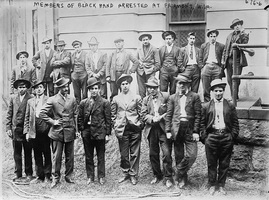 | Back to e-WV
| Back to e-WV
 The West Virginia Encyclopedia
The West Virginia Encyclopedia
 | Back to e-WV
| Back to e-WV
 The West Virginia Encyclopedia
The West Virginia Encyclopedia

The Black Hand was the name and symbol of an underworld society of Italian immigrants that, during the first decades of the 20th century, sought to extort money from other Italian immigrants. Thriving in Sicily in the late 19th century, the Black Hand came to the New World as part of the great migration to America’s mines and factories. Soon the mysterious society operated in West Virginia.
The Black Hand intimidated victims by sending threatening letters, accompanied by crude drawings of a hand painted black. Italians are the largest ethnic group in West Virginia, and their businessmen were the most frequent targets. Sometimes, the Black Hand sought to exploit miners. Some victims refused to pay, fought back, and were left alone.
Trials at several county courthouses led to the eradication of the group. On February 11, 1923, eight members of the Black Hand were arrested in Harrison County. Their successful prosecution constituted one of the most famous trials in Clarksburg, the county seat. The trial capped a three-year period when several mysterious murders in the county involved alleged gangland vendettas.
John C. McKinney, a police chief and detective at Fairmont, was active in the investigations of the gang in Marion and Harrison counties. He authored a paper titled ‘‘Black Hand,’’ in which he reports how Tusca Morris, prosecuting attorney in Marion County, helped eliminate the organization there. Frank Amos, who also served as prosecutor in Marion, acted against the group, as did Will Morris in Harrison County. William Cramer, the prosecuting attorney of Monongalia County, helped convict members of the Black Hand despite threats on his life.
Extortion victims testified at the trials. An immigrant, Francisco Beradelli, helped bring down the Black Hand in northern West Virginia by joining the organization and informing on its workings. In Marion County an Italian immigrant shot a Black Hander who tried to extort him. The law set the shooter free. There is no reported case in which those who resisted were punished by the Black Hand.
Written by Norman Julian
Comstock, Jim, ed. West Virginia Heritage Encyclopedia vol. 3. Richwood: Jim Comstock, 1976.
Davis, Dorothy. History of Harrison County. Clarksburg: American Association of University Women, 1970.
Belanger, Ruth. Thomas and its Opera House. Goldenseal, (October-December 1980).